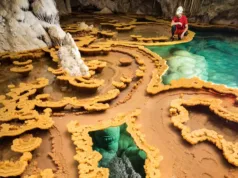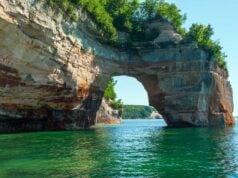The Manpupuner Rock Formations, also known as the Manpupuner Plateau or Seven Strong Men Rock Formations, are a unique and mysterious set of seven towering stone pillars located in the northern part of the Ural Mountains in the Komi Republic, Russia. These rock formations are renowned for their distinctive and otherworldly appearance, making them a popular natural attraction.

Overview: The Manpupuner Rock Formations consist of seven massive stone pillars, each reaching heights of up to 30 meters (98 feet). The rocks are composed of ancient weathered granite and have distinctive shapes that evoke a sense of human or anthropomorphic figures, leading to the nickname “Seven Strong Men.” The geological processes that formed these structures are not entirely understood, adding an element of mystery to their allure.
Geographic Location: The Manpupuner Rock Formations are situated in a remote and pristine wilderness within the Ural Mountains. Specifically, they are located on the Manpupuner Plateau in the Troitsko-Pechorsky District of the Komi Republic, Russia. The precise coordinates are approximately 65.2745° N latitude and 59.2236° E longitude.
Accessibility: Reaching the Manpupuner Rock Formations can be a challenging adventure due to their remote location and the lack of established infrastructure. The journey typically involves a combination of road and hiking, with the nearest settlement being the village of Ivdel. Travelers often hire local guides or join organized tours to navigate the rugged terrain and navigate through the wilderness.
Visitors are advised to plan their trips carefully, considering factors such as weather conditions and the limited availability of amenities in the area. The remote and untouched nature of the Manpupuner Plateau contributes to the sense of adventure and exploration associated with a visit to these enigmatic rock formations.
Origin and Geological History of The Manpupuner Rock Formations

The Manpupuner Rock Formations are believed to have originated through the process of exfoliation, a type of weathering that results in the peeling away of outer layers of rock. This geological phenomenon occurs as a result of various factors, including freeze-thaw cycles, expansion and contraction of minerals, and other weathering processes.
The granite rocks that make up the Manpupuner formations are estimated to be around 200 million years old, dating back to the Upper Permian or Lower Triassic period. The region was once covered by a shallow sea, and the granite likely formed through the slow cooling and solidification of molten rock beneath the Earth’s surface. Over millions of years, geological forces, including uplift and erosion, shaped the landscape, exposing the unique pillars we see today.
Composition and Characteristics:
The rocks are primarily composed of granite, a type of intrusive igneous rock that forms from the slow crystallization of magma beneath the Earth’s surface. Granite is known for its durability and resistance to weathering, making it a common component of many impressive rock formations. The specific geological processes that shaped the Manpupuner pillars into their distinct forms are not fully understood, adding an element of mystery to their origin.
The pillars exhibit striking anthropomorphic shapes, with some formations resembling human figures, hence the nickname “Seven Strong Men.” The tallest pillar reaches approximately 30 meters in height, making them a unique and visually captivating natural wonder.
Theories about the Formation Process:
Several theories attempt to explain the formation of the Manpupuner Rock Formations:
- Exfoliation and Erosion: The prevailing theory suggests that exfoliation, combined with erosion caused by wind, water, and ice, played a significant role in shaping the pillars. As outer layers of rock peeled away over time, the pillars assumed their distinctive forms.
- Frost Weathering: The harsh climate of the region, characterized by extreme temperature fluctuations, may have contributed to the weathering process. Frost action, where water infiltrates cracks in the rock, freezes, and expands, could have played a role in shaping the pillars.
- Differential Weathering: Variations in the composition and mineral content of the granite may have led to uneven weathering, resulting in the formation of distinct shapes and figures.
Despite these theories, the exact sequence of geological events that led to the creation of the Manpupuner Rock Formations remains a subject of scientific interest and study. The unique and mysterious nature of these pillars continues to capture the imagination of geologists and visitors alike.
The Manpupuner Rock Formations’s Physical Features
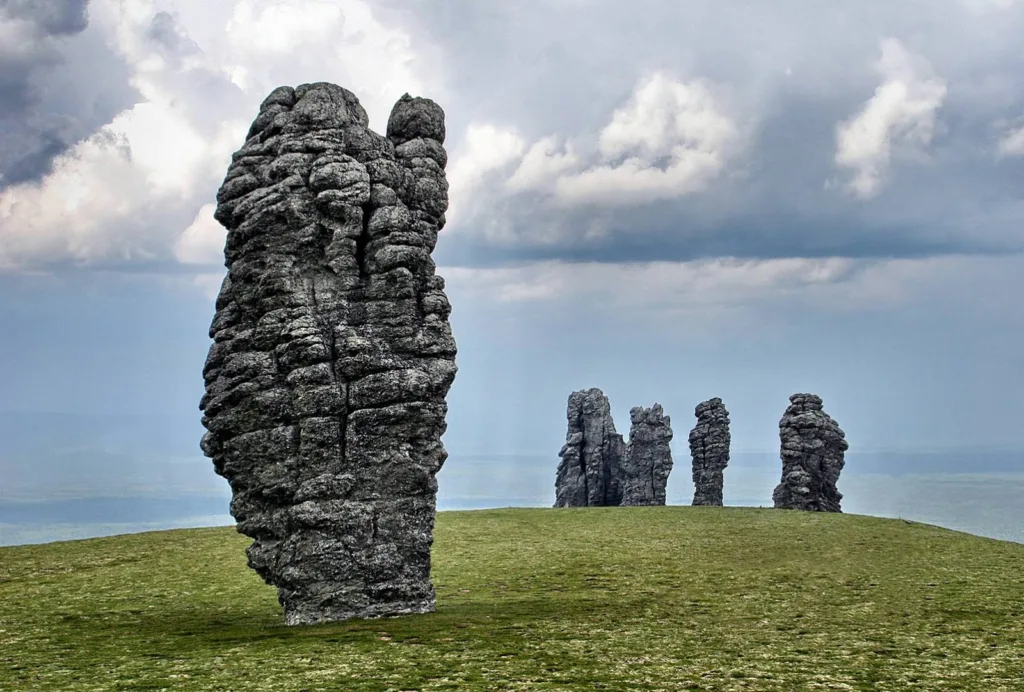
The physical features of the Manpupuner Rock Formations contribute to their enigmatic and captivating appearance. Here are some key aspects of their physical characteristics:
- Granite Composition: The rocks that make up the Manpupuner Formations are primarily composed of granite. Granite is an intrusive igneous rock known for its durability and resistance to weathering. The specific type of granite in this region contributes to the unique shapes and structures of the pillars.
- Distinctive Shapes: The most striking feature of the Manpupuner Rock Formations is their anthropomorphic shapes. The seven pillars resemble giant stone figures, and each has its own distinct form. Some appear to resemble human figures, while others may evoke animal shapes. The combination of these unique shapes adds to the allure and mystery of the site.
- Height and Size: The pillars vary in height, with the tallest reaching up to approximately 30 meters (98 feet). The size and scale of these structures contribute to their visual impact and make them a remarkable natural wonder in the remote Ural Mountains.
- Exfoliation Patterns: The rocks exhibit patterns of exfoliation, where outer layers of rock have peeled away over time. This process, likely influenced by weathering factors such as freeze-thaw cycles, has contributed to the smooth and rounded appearance of the pillars.
- Remote Location: The Manpupuner Rock Formations are situated in a remote and pristine wilderness, surrounded by the vast and untouched landscapes of the Ural Mountains. This remoteness adds to the sense of adventure for those who seek to visit the site.
- Natural Surroundings: The formations are set against a backdrop of rugged terrain, dense forests, and tundra, creating a stark and dramatic contrast with the smooth granite pillars. The natural surroundings enhance the overall aesthetic and provide a sense of the harsh, yet beautiful, environment in which these rock formations exist.
- Mysterious Atmosphere: The combination of the unique shapes, the remote location, and the lack of a definitive explanation for their formation contributes to the mysterious atmosphere surrounding the Manpupuner Rock Formations. Visitors often describe a sense of awe and wonder when encountering these geological wonders.
Overall, the physical features of the Manpupuner Rock Formations make them a one-of-a-kind natural spectacle, attracting geologists, photographers, and adventure seekers from around the world. The interplay of geological processes and the harsh beauty of the Ural Mountains create an unforgettable and mysterious landscape.
Cultural and Mythological Significance
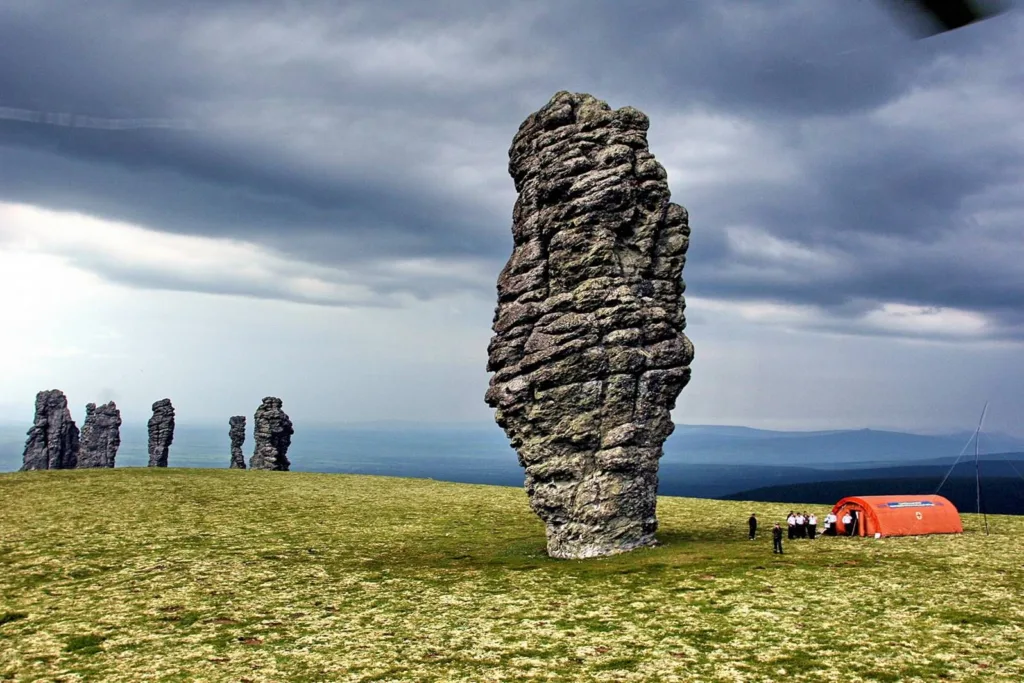
The Manpupuner Rock Formations hold cultural and mythological significance for the indigenous people of the Komi Republic and have also become a subject of fascination for those beyond the local communities. Here are some aspects of their cultural and mythological importance:
- Indigenous Komi Beliefs: The Komi people, who are the indigenous inhabitants of the Komi Republic, have various myths and legends associated with the Manpupuner Rock Formations. These stories often attribute the creation of the pillars to supernatural or mystical forces, and the site is considered sacred in some Komi traditions.
- Spiritual and Sacred Site: For some indigenous communities, the Manpupuner Rock Formations are regarded as a sacred site with spiritual significance. The pillars are sometimes associated with deities, spirits, or legendary figures in local mythology.
- Cultural Heritage: The rock formations are part of the cultural heritage of the Komi people, and they may be featured in local art, folklore, and traditional practices. The pillars serve as a symbol of the deep connection between the indigenous communities and their natural surroundings.
- Tourist Attraction and Folklore: As the Manpupuner Rock Formations gained attention as a tourist attraction, they became a subject of interest in broader Russian and international folklore. The distinctive shapes of the pillars have inspired various stories and interpretations, further contributing to their mythological aura.
- Photography and Artistic Inspiration: The visually striking nature of the rock formations has made them a favorite subject for photographers and artists. The pillars often appear in various forms of visual art, further embedding them in cultural representations beyond their geographical location.
- Modern Cultural Impact: In addition to their historical and indigenous significance, the Manpupuner Rock Formations have become a symbol of the Ural Mountains and the Komi Republic. They are featured in travel literature, documentaries, and promotional materials, contributing to their cultural impact and recognition on a global scale.
- Legends and Folk Stories: Various legends and folk stories have emerged around the Manpupuner Rock Formations, explaining their origin and unique shapes. These stories may vary among different communities and individuals, adding to the rich tapestry of cultural narratives associated with the site.
In summary, the cultural and mythological significance of the Manpupuner Rock Formations is deeply rooted in the beliefs and traditions of the indigenous Komi people. Additionally, as the site gained prominence, it became a source of inspiration and fascination for a broader audience, contributing to its cultural importance beyond the local communities.
Tourism and Visitor Experience of The Manpupuner Rock Formations
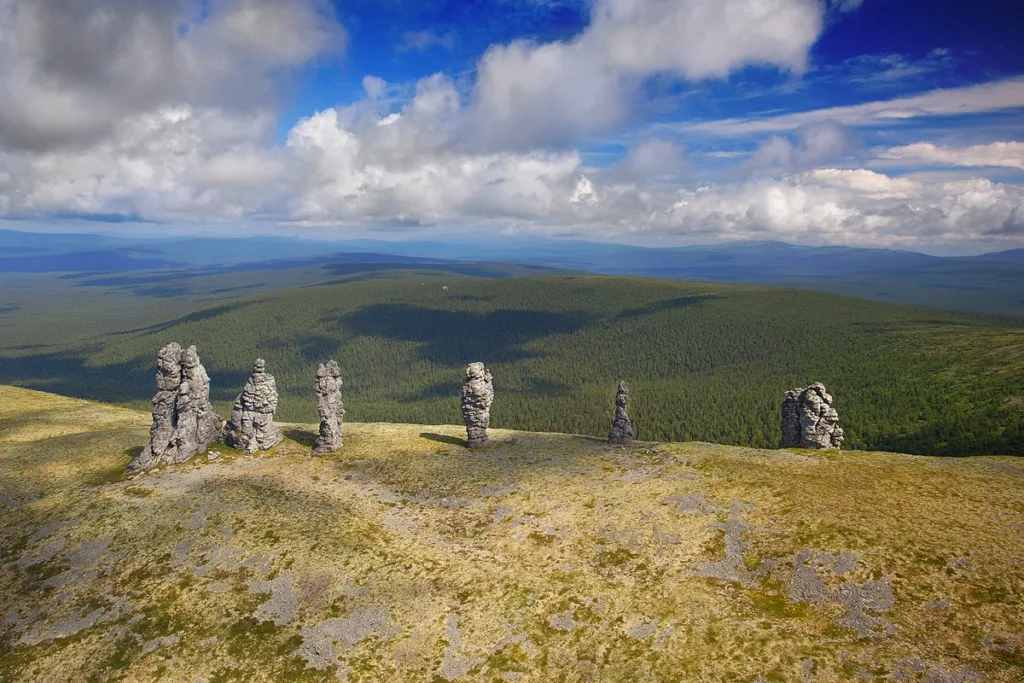
The Manpupuner Rock Formations, despite their remote location, have become a popular tourist attraction, drawing visitors from Russia and around the world. Here’s a look at the tourism and visitor experience associated with this unique geological wonder:
- Challenges of Accessibility: Getting to the Manpupuner Rock Formations can be challenging due to their remote location in the northern Ural Mountains. Visitors often need to travel by road, and then undertake a hike through the wilderness to reach the site. The journey requires careful planning, and many tourists opt for guided tours to navigate the rugged terrain.
- Seasonal Considerations: The site’s accessibility is highly dependent on the season. In winter, the region experiences extreme cold and heavy snowfall, making it difficult to reach the formations. Summer is generally the preferred time for visits when the weather is milder and the landscape is more accessible.
- Guided Tours: Many visitors choose to join guided tours led by local experts who are familiar with the terrain. These tours provide not only logistical support but also insights into the geological and cultural aspects of the Manpupuner Rock Formations.
- Camping and Accommodation: Given the remote nature of the location, camping is a common way for visitors to experience the area. Camping sites may be set up near the rock formations, allowing tourists to immerse themselves in the wilderness. Some guided tours may also include overnight stays in basic accommodations in nearby villages.
- Photography and Observation: The Manpupuner Rock Formations are a haven for photographers and nature enthusiasts. The unique shapes and the stark landscape provide excellent opportunities for capturing breathtaking images. Visitors often spend time observing the formations and exploring the surrounding natural beauty.
- Cultural Experiences: Tourists may have the opportunity to learn about the cultural and mythological significance of the site from local guides. This may include stories from indigenous Komi traditions and folklore associated with the rock formations.
- Preservation Efforts: Due to the increasing popularity of the site, there is a growing awareness of the need for responsible tourism and environmental preservation. Efforts are made to minimize the impact of visitors on the delicate ecosystem and to ensure that the Manpupuner Rock Formations remain an untouched natural wonder.
- Weather Considerations: Visitors should be prepared for varying weather conditions, including rain and sudden temperature changes. The climate in the Ural Mountains can be unpredictable, and proper clothing and equipment are essential for a comfortable experience.
In conclusion, the tourism and visitor experience at the Manpupuner Rock Formations combine adventure, natural beauty, and cultural exploration. While the journey may be challenging, the reward is a chance to witness one of Russia’s most unique and mysterious geological wonders. Responsible tourism practices are crucial to preserving the site’s natural integrity and ensuring its continued accessibility for future generations.
Conclusion

The Manpupuner Rock Formations stand as a testament to the fascinating interplay of geological processes, cultural significance, and environmental uniqueness. As we recap the importance of Manpupuner, we find that it holds a distinctive place in the world for several reasons:
Geological Significance:
- Formation Mystery: The unique shapes and formations of the seven pillars remain a geological mystery, adding to their allure and sparking scientific curiosity.
- Granite Composition: Composed of ancient granite, the rocks have withstood the test of time, showcasing the enduring beauty of natural geological features.
Cultural Importance:
- Indigenous Beliefs: The Manpupuner Rock Formations hold deep cultural and spiritual significance for the indigenous Komi people, embodying a connection between the natural world and their traditions.
- Mythological Symbolism: Legends and myths associated with the formations contribute to a rich cultural tapestry, making them a source of inspiration and storytelling.
Touristic Attraction:
- Remote Adventure: The remote location and challenging accessibility contribute to the sense of adventure for visitors, attracting those seeking an authentic and off-the-beaten-path experience.
- Photographic Marvel: The visually striking pillars have become a favorite subject for photographers, capturing the imagination of nature enthusiasts and travelers alike.
Environmental Importance:
- Preservation Needs: As tourism to Manpupuner grows, there is an increasing awareness of the need for responsible tourism to preserve the delicate ecosystem and maintain the site’s natural integrity.
- Wilderness Sanctuary: The surrounding wilderness of the Ural Mountains adds to the environmental importance, emphasizing the need to balance tourism with conservation efforts.
In conclusion, the Manpupuner Rock Formations are not merely geological wonders but a harmonious blend of cultural, geological, and environmental elements. They serve as a reminder of the Earth’s intricate processes, the richness of cultural heritage, and the importance of responsible stewardship to ensure that such natural marvels endure for future generations. Visiting Manpupuner is not just a journey into the heart of the Ural Mountains; it’s an exploration of the intersection of nature, culture, and the human spirit.


























